Oracle ATG Web Commerce to Shopify Migration - Step-by-Step Guide & Expert Services
Oracle ATG Web Commerce to Shopify migration made simple. Ready to move Oracle ATG Web Commerce store to Shopify with confidence? Cart2Cart provides a secure, fast, and reliable way to transfer data, ensuring zero downtime and complete SEO preservation. Whether you're researching how to switch from Oracle ATG Web Commerce to Shopify with our step-by-step guide, or need expert assistance to manage the entire process, we deliver a smooth Oracle ATG Web Commerce to Shopify migration. Get started today!
What data can be
migrated from Oracle ATG Web Commerce to Shopify
-
Products
-
Product Categories
-
Manufacturers
-
Customers
-
Orders
Estimate your Migration Cost
Thanks to Cart2Cart`s flexible pricing policy, the migration price depends on the number of transferred entities and the additional migration options you select. Just choose your Source and Target platforms and get the approximate price of your Oracle ATG Web Commerce to Shopify store conversion right after finishing the free Demo.
How to Migrate from Oracle ATG Web Commerce to Shopify In 3 Steps?
Connect your Source & Target carts
Choose Oracle ATG Web Commerce and Shopify from the drop-down lists & provide the stores’ URLs in the corresponding fields.
Select the data to migrate & extra options
Choose the data you want to migrate to Shopify and extra options to customise your Oracle ATG Web Commerce to Shopify migration.
Launch your Demo/Full migration
Run a free Demo to see how the Cart2Cart service works, and when happy - launch Full migration.
Migrate from Oracle ATG Web Commerce to Shopify: Your Comprehensive How-To Guide
Migrate from Oracle ATG Web Commerce to Shopify: Your Comprehensive How-To Guide
Oracle ATG Web Commerce has long served as a robust, enterprise-grade platform for complex e-commerce operations. However, for many merchants, the landscape is shifting towards more agile, cloud-native solutions that offer enhanced user experience, a vast app ecosystem, and streamlined management. Shopify, with its unparalleled ease of use, scalability, and rich feature set, has emerged as a prime candidate for businesses looking to replatform. This guide will walk you through the entire process of migrating your online store data from Oracle ATG Web Commerce to Shopify, ensuring a smooth and efficient transition.
Given the highly customized nature of Oracle ATG installations, direct API connections for automated migration tools are often not feasible. Therefore, the most reliable and common method for data transfer involves exporting your crucial store data into CSV files from your Oracle ATG environment. These CSV files will then serve as the source for a migration tool like Cart2Cart, which will facilitate the seamless import into your new Shopify store.
Prerequisites for Migration
Before embarking on your data migration journey, it's essential to prepare both your current Oracle ATG Web Commerce store and your future Shopify store. Proper preparation minimizes disruptions and ensures data integrity.
- For Your Oracle ATG Web Commerce Store (Source):
- Data Export: You will need to extract your store's data into well-structured CSV files. This typically requires custom scripts or manual export functionalities within your Oracle ATG system. Key entities to export include:
- Products (including SKUs, variants, descriptions, images, prices)
- Product Categories
- Customer information (names, emails, addresses)
- Order history (order IDs, line items, customer association, statuses, order dates)
- Product Reviews
- CMS Pages (content, metadata)
- Blog Posts
- Data Cleansing: This is an opportune moment to clean up your existing data. Remove outdated products, duplicate customer entries, or irrelevant information to ensure only high-quality data is transferred to Shopify.
- Access: Ensure you have full administrative access to your Oracle ATG system to perform the necessary data exports.
For more details on preparing your source store, read our How to prepare Source store for migration? FAQ.
- Data Export: You will need to extract your store's data into well-structured CSV files. This typically requires custom scripts or manual export functionalities within your Oracle ATG system. Key entities to export include:
- For Your Shopify Store (Target):
- Shopify Account: Set up a new Shopify store or ensure you have administrative access to your existing one.
- App Installation: Be prepared to install the Cart2Cart Store Migration App from the Shopify App Store, as it is required for connecting your Shopify target store.
- Disable Notifications: It is highly recommended to disable all store notifications during the migration process to prevent customers from receiving incomplete or erroneous updates.
- Review App: Note that product reviews on Shopify often require a dedicated app, such as AirReviews, which may need to be integrated post-migration.
- Understand Plan Limitations: If you are on a Shopify "Pause and Build" plan, be aware that it blocks orders, which could impact testing.
Consult our How to prepare Target store for migration? guide for additional insights.
Performing the Migration: A Step-by-Step Guide
This section outlines the process of transferring your Oracle ATG data (via CSV) to Shopify using a migration wizard. For this guide, we assume the use of a tool like Cart2Cart, which simplifies the data transfer process.
Step 1: Get Started with the Migration Wizard
Begin by accessing the migration wizard. This is where you'll initiate your data transfer from Oracle ATG (via CSV) to Shopify.
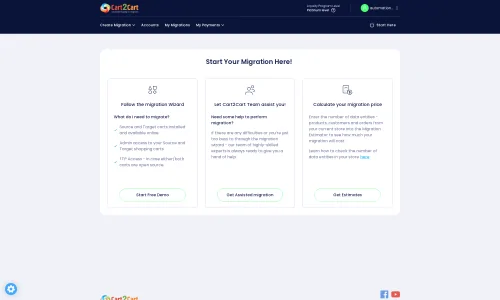
Step 2: Configure Your Source Store (Oracle ATG via CSV)
In this crucial step, you'll specify your source platform as 'CSV File to Cart'. This signifies that you will be uploading the CSV files containing your extracted Oracle ATG data.
- Select 'CSV File to Cart' from the list of available platforms.
- Upload your prepared CSV files containing your product data, customer details, order history, and other entities. Ensure your CSVs are correctly formatted according to the tool's requirements.
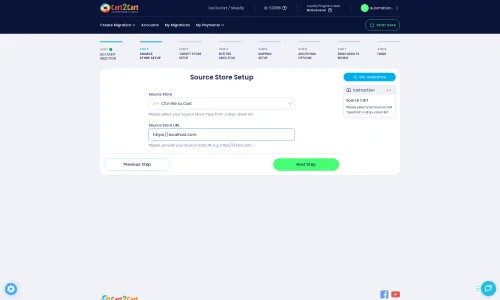
This method allows for a flexible transfer of various data types, including Products, Categories, Manufacturers, Reviews, Customers, Orders, Invoices, Taxes, Stores, Coupons, CMS Pages, and Blog Posts. Learn more about CSV.File Data Migration.
Step 3: Connect Your Target Store (Shopify)
Now, it's time to set up your new Shopify store as the migration target.
- Select 'Shopify' from the dropdown menu of target platforms.
- The recommended connection method is to 'Install App from Marketplace'. Click the provided link to navigate to the Shopify App Store, install the Cart2Cart Store Migration App, and follow the on-screen instructions. This app is essential for establishing a secure connection and enabling data transfer.
- Alternatively, you can choose to 'Provide API Access Credentials' if you prefer a manual setup. This typically involves creating a custom app in your Shopify admin, configuring the necessary API scopes, and obtaining an Admin API access token.
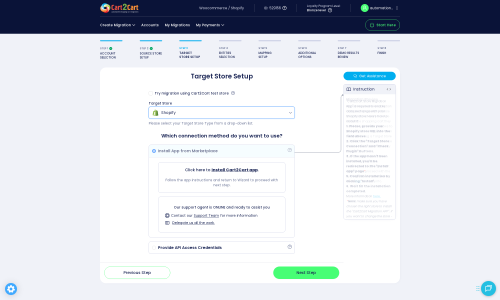
For detailed guidance on access credentials, refer to The Short & Essential Guide to Access Credentials for Cart2Cart.
Step 4: Select Data Entities for Transfer
This stage allows you to specify which types of data you wish to transfer from your CSV files to Shopify.
- You can choose to migrate 'All entities' for a comprehensive data transfer, or select specific items such as:
- Products (including SKUs and variants)
- Product Categories
- Customers
- Orders
- CMS Pages
- Blogs & Blog Posts
- Product Reviews
- Coupons & Price Rules (Shopify specific)
- Review the selected entities carefully to ensure all crucial information is included in your data transfer plan.
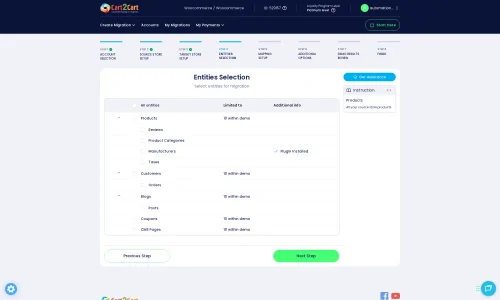
Step 5: Configure Data Mapping and Additional Options
This step is vital for ensuring your data is correctly structured and optimized for Shopify.
- Data Mapping: Match the various data fields from your CSV files (Oracle ATG) to the corresponding fields in Shopify. This includes customer groups, order statuses, and other attributes. Accurate data mapping is crucial for maintaining data integrity and a seamless user experience on your new platform.
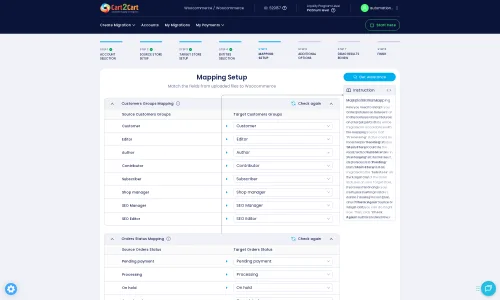
- Additional Options: Enhance your migration by selecting various additional options:
- Clear Target Store Data: If your Shopify store is brand new or you wish to start with a clean slate, you can choose to clear current data on target store before migration option.
- Preserve Order IDs: This option helps maintain historical records and accounting consistency. Learn more about how Preserve IDs options can be used.
- SEO URLs & 301 Redirects: Crucial for maintaining your SEO rankings and link equity. Ensure that your old Oracle ATG URLs are properly redirected to your new Shopify URLs.
- Migrate Images in Description: Transfers images embedded within product descriptions or CMS pages.
- Migrate All Categories: Ensures a complete transfer of your product taxonomy.
- Migrate Groups to Tags: A Shopify-specific option that converts customer groups from your source data into customer tags in Shopify.
- Password Migration: If available, this option transfers customer passwords. Note that this often requires specific modules or secure handling due to security protocols.
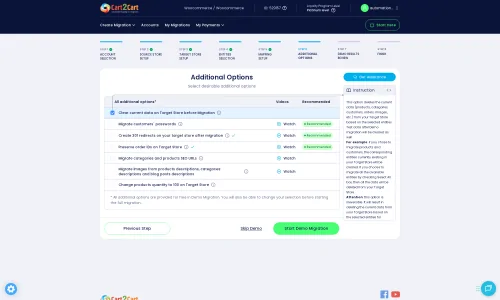
Step 6: Run a Free Demo Migration
Before committing to the full data transfer, execute a free demo migration. This allows you to:
- Transfer a limited number of entities (e.g., 10-20 products, customers, orders).
- Evaluate the migration process and ensure data is transferred correctly.
- Check the integrity of your product SKUs, variants, customer data, and order details.
Thoroughly review the demo results to identify any potential issues or adjustments needed before proceeding with the full migration.
Step 7: Initiate Full Migration
Once you are satisfied with the demo results, proceed with the full migration of all your selected data entities.
- Monitor the progress of the data transfer.
- Consider opting for a Migration Insurance Service, which offers additional remigrations within a specified period, providing peace of mind. Find out how Migration Insurance works.
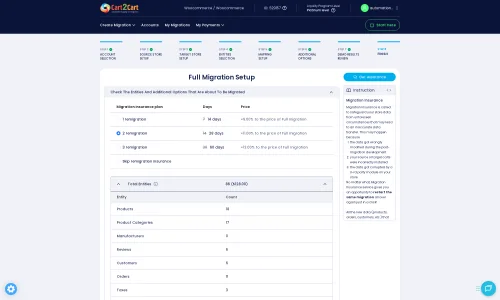
Post-Migration Steps
The migration doesn't end when the data transfer is complete. Several critical steps are needed to ensure your new Shopify store is fully functional and optimized.
- Thorough Data Verification: Rigorously check all migrated data. Verify products (SKUs, pricing, images, descriptions, variants), categories, customer accounts, order history, CMS pages, and blog posts. Ensure that metadata and all attributes have been correctly transferred.
- Configure SEO and Redirects: Implement 301 redirects for any URLs that may have changed during the replatforming process. This is crucial for maintaining your SEO rankings and preserving link equity. Update your sitemap and submit it to search engines.
- Set Up Payment and Shipping Gateways: Configure and thoroughly test all your preferred payment processors and shipping methods on Shopify.
- Install Essential Apps: Leverage Shopify's extensive App Store to install apps for functionalities like customer reviews (e.g., the AirReviews app if needed), marketing automation, analytics, and accounting.
- Theme Customization and User Experience: Fine-tune your Shopify theme to align with your brand identity and optimize for a superior user experience. Test responsiveness across various devices.
- Perform Test Orders: Place several test orders as a customer and go through the entire purchase flow, from adding to cart to checkout and order confirmation, to ensure everything works flawlessly.
- Update DNS Settings: Once you are confident in your new Shopify store, update your domain's DNS settings to point to your Shopify store.
- Disable Old Store: After successful domain redirection and complete verification, consider disabling or archiving your old Oracle ATG Web Commerce store.
- Recent Data Migration: If your Oracle ATG store remained active during the migration, utilize a Recent Data Migration Service to transfer any new orders or customer registrations that occurred post-initial migration. This ensures no data is lost during the transition period.
Migrating from a powerful system like Oracle ATG Web Commerce to Shopify is a significant undertaking, but with careful planning and execution, it can lead to a more flexible, scalable, and user-friendly e-commerce platform. Should you require expert assistance at any stage, do not hesitate to Contact Us for tailored support.
Ways to perform migration from Oracle ATG Web Commerce to Shopify
Automated migration
Just set up the migration and choose the entities to move – the service will do the rest.
Try It Free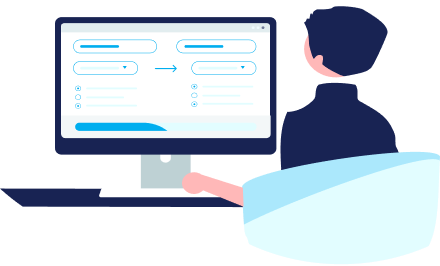
Data Migration Service Package
Delegate the job to the highly-skilled migration experts and get the job done.
Choose Package

Benefits for Store Owners

Benefits for Ecommerce Agencies
Choose all the extra migration options and get 40% off their total Price

The design and store functionality transfer is impossible due to Oracle ATG Web Commerce to Shopify limitations. However, you can recreate it with the help of a 3rd-party developer.
Your data is safely locked with Cart2Cart
We built in many security measures so you can safely migrate from Oracle ATG Web Commerce to Shopify. Check out our Security Policy
Server Security
All migrations are performed on a secure dedicated Hetzner server with restricted physical access.Application Security
HTTPS protocol and 128-bit SSL encryption are used to protect the data being exchanged.Network Security
The most up-to-date network architecture schema, firewall and access restrictions protect our system from electronic attacks.Data Access Control
Employee access to customer migration data is restricted, logged and audited.Frequently Asked Questions
Should I use an automated tool or hire an expert for Oracle ATG Web Commerce to Shopify migration?
Can customer passwords be migrated from Oracle ATG Web Commerce to Shopify?
What data entities can be migrated from Oracle ATG Web Commerce to Shopify?
Is my data secure during the Oracle ATG Web Commerce to Shopify migration?
How can I ensure data accuracy after migrating from Oracle ATG Web Commerce to Shopify?
Will my store's design and theme be transferred from Oracle ATG Web Commerce to Shopify?
How can I prevent losing SEO rankings when migrating from Oracle ATG Web Commerce to Shopify?
How long does a typical migration from Oracle ATG Web Commerce to Shopify take?
What factors influence the cost of migrating from Oracle ATG Web Commerce to Shopify?
Will my Oracle ATG Web Commerce store experience downtime during migration to Shopify?
Why 150.000+ customers all over the globe have chosen Cart2Cart?
100% non-techie friendly
Cart2Cart is recommended by Shopify, WooCommerce, Wix, OpenCart, PrestaShop and other top ecommerce platforms.
Keep selling while migrating
The process of data transfer has no effect on the migrated store. At all.
24/7 live support
Get every bit of help right when you need it. Our live chat experts will eagerly guide you through the entire migration process.
Lightning fast migration
Just a few hours - and all your store data is moved to its new home.
Open to the customers’ needs
We’re ready to help import data from database dump, csv. file, a rare shopping cart etc.
Recommended by industry leaders
Cart2Cart is recommended by Shopify, WooCommerce, Wix, OpenCart, PrestaShop and other top ecommerce platforms.


























